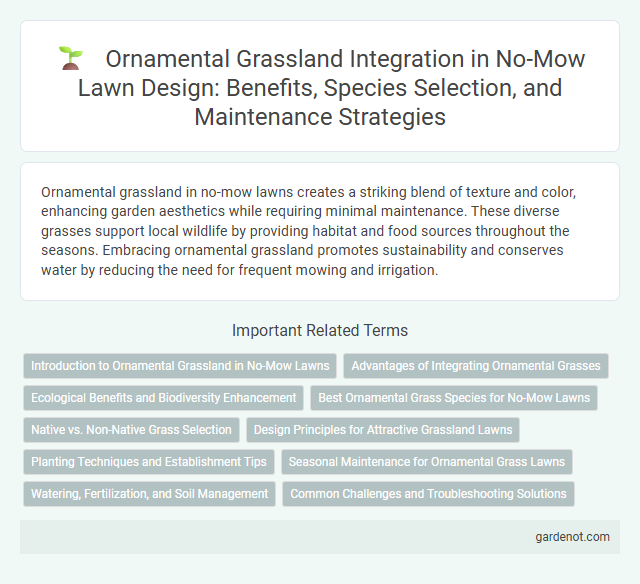Ornamental grassland in no-mow lawns creates a striking blend of texture and color, enhancing garden aesthetics while requiring minimal maintenance. These diverse grasses support local wildlife by providing habitat and food sources throughout the seasons. Embracing ornamental grassland promotes sustainability and conserves water by reducing the need for frequent mowing and irrigation.
Introduction to Ornamental Grassland in No-Mow Lawns
Ornamental grassland in no-mow lawns enhances biodiversity by supporting native flora and fauna while reducing maintenance efforts. These grasslands feature a mix of native grasses and wildflowers, creating a visually appealing and ecologically sustainable landscape. Incorporating ornamental grassland promotes soil health and conserves water, making it an ideal choice for environmentally conscious homeowners.
Advantages of Integrating Ornamental Grasses
Integrating ornamental grasses into a no-mow lawn enhances biodiversity by providing habitat and food for pollinators and other beneficial insects. These grasses require minimal maintenance, reducing water usage and the need for fertilizers, contributing to environmental sustainability. Their deep root systems improve soil health and prevent erosion, promoting a resilient and low-maintenance landscape.
Ecological Benefits and Biodiversity Enhancement
Ornamental grasslands in no-mow lawns provide critical habitats that support pollinators, birds, and beneficial insects, boosting local biodiversity. These low-maintenance grasslands improve soil health by enhancing microbial activity and reducing erosion. Their deep root systems increase water retention, mitigate urban heat island effects, and contribute to carbon sequestration.
Best Ornamental Grass Species for No-Mow Lawns
The best ornamental grass species for no-mow lawns include Carex oshimensis (Japanese sedge), Festuca glauca (blue fescue), and Deschampsia cespitosa (tufted hairgrass), valued for their low maintenance and aesthetic appeal. These grasses thrive in various soil conditions, require minimal watering, and create dense, textured landscapes that suppress weeds and reduce mowing needs. Incorporating native species like Bouteloua gracilis (blue grama) enhances biodiversity and sustainability in no-mow lawn designs.
Native vs. Non-Native Grass Selection
Selecting native grasses for ornamental no-mow lawns promotes biodiversity by providing habitat for local wildlife and requiring less water and maintenance than non-native species. Native grasses like Switchgrass (Panicum virgatum) and Little Bluestem (Schizachyrium scoparium) are well-adapted to regional climate conditions, enhancing soil health and reducing the need for fertilizers. Non-native ornamental grasses may offer aesthetic variety but often demand higher inputs and can outcompete native flora, potentially disrupting local ecosystems.
Design Principles for Attractive Grassland Lawns
Ornamental grassland lawns thrive by selecting diverse native grass species that provide texture, height variation, and seasonal interest, ensuring ecological balance and visual appeal. Incorporating strategically placed flowering perennials attracts pollinators and enhances biodiversity, while naturalistic patterns mimic meadow ecosystems and reduce maintenance needs. Proper soil preparation and adaptive mowing regimes promote healthy root systems and sustainable growth, resulting in an attractive, resilient no-mow lawn.
Planting Techniques and Establishment Tips
Ornamental grassland thrives when selecting native grasses suited to local climate and soil conditions, ensuring sustainable growth with minimal maintenance. Planting techniques emphasize seed stratification and shallow sowing to promote uniform germination, while mulching helps retain moisture during establishment. Regular monitoring during the first growing season aids in controlling weeds and supports healthy root development for a resilient no-mow lawn.
Seasonal Maintenance for Ornamental Grass Lawns
Seasonal maintenance for ornamental grass lawns in no-mow landscapes centers on minimal intervention to preserve natural aesthetics and ecological balance. Early spring cutbacks remove dead foliage, promoting fresh growth while enriching soil health through organic matter decomposition. Late autumn trimming prevents pest buildup and prepares grasses for winter dormancy, ensuring vibrant regrowth in subsequent seasons with reduced labor and resource input.
Watering, Fertilization, and Soil Management
Ornamental grasslands in no-mow lawns require minimal watering, ideally about 1 inch per week, to promote deep root growth and drought resilience. Fertilization should be applied sparingly with slow-release, low-nitrogen formulas to maintain plant health without encouraging excessive foliage. Proper soil management involves regular aeration and the addition of organic matter to improve drainage and nutrient retention, supporting robust ornamental grasses.
Common Challenges and Troubleshooting Solutions
Common challenges in maintaining ornamental no-mow grasslands include weed invasion, uneven growth, and pest infestations, which can diminish aesthetic appeal and plant health. Regular monitoring combined with targeted interventions, such as selective herbicide application, strategic planting of native species to outcompete weeds, and integrated pest management, effectively addresses these issues. Proper site assessment and soil preparation before establishing ornamental grasslands are crucial steps to minimize future maintenance problems.
Ornamental grassland Infographic

 gardenot.com
gardenot.com